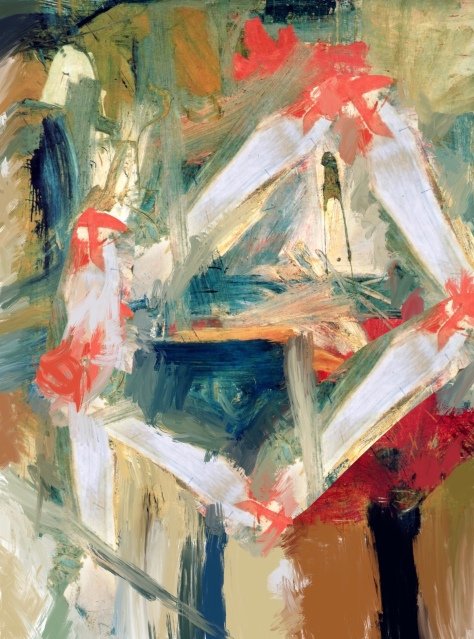Drawing inspiration from Willem de Kooning’s iconic “February [1957],” Van Buskirk presents a thought-provoking composition that reimagines and recontextualizes the original elements, challenging the boundaries of artistic creation and pushing the boundaries of perception.
Exploration of Elements:
The painting consists of three copies of the original white stroke from de Kooning’s “February [1957],” cleverly arranged to form a square shape. This arrangement highlights the significance of repetition and symmetry, providing a sense of balance and harmony within the artwork. By employing copies of the white stroke, Van Buskirk pays homage to de Kooning’s original work while adding his own distinctive touch.
Additionally, the square formed by the white strokes is joined by five red asterisks, four of which are copies of the original red asterisk from de Kooning’s “February [1957].” The introduction of the red asterisks introduces a burst of vibrant color to the composition, contrasting against the stark white strokes. These red asterisks serve as focal points, drawing attention and guiding the viewer’s gaze throughout the artwork. Through this juxtaposition, Van Buskirk explores the interplay between color and form, accentuating the visual impact of the piece.
Themes and Concepts:
Van Buskirk’s painting raises intriguing questions about the nature of originality, reproduction, and artistic inspiration. The utilization of copies from de Kooning’s “February [1957]” challenges traditional notions of authorship and invites a deeper examination of artistic lineage. By incorporating these elements, Van Buskirk acknowledges the influence of de Kooning’s work and establishes a dialogue with the art historical context.
Symbolism and Visual Impact:
The square formed by the three white strokes symbolizes stability and balance within the composition. Its geometric shape provides a strong visual anchor, encouraging viewers to contemplate the interplay between the strokes and the connecting asterisks. The repetition of the red asterisks introduces a sense of rhythm and movement, creating a dynamic tension within the artwork.
The use of color also holds symbolic meaning. The white strokes represent purity and openness, inviting viewers to engage with the artwork on a contemplative level. Conversely, the red asterisks evoke energy, passion, and intensity, juxtaposing the serene white strokes and adding vibrancy to the composition.
The arrangement of the white strokes into a square, along with the joining of the red asterisks, presents an exploration of transformation and unity. The square shape symbolizes stability, order, and containment, contrasting against the dynamic and fluid strokes of de Kooning’s original artwork. Through this transformation, Van Buskirk emphasizes the transformative power of artistic interpretation and the ability of artists to reinterpret and reshape existing ideas.
The Title:
In addition to its descriptive nature, the lengthy and detailed title of Todd Van Buskirk’s painting serves a purpose by providing directions for the painting surface. By explicitly stating the specific arrangement and joining of the elements, such as the three copies of the original white stroke and the five red asterisks, the title acts as a set of instructions for how the composition should be executed on the canvas.
Van Buskirk’s title guides the artist or anyone reproducing the painting in recreating the intended visual representation. It specifies the precise placement and configuration of the strokes and asterisks, forming a square shape and connecting the elements in a specific manner. This ensures that the painting is rendered in accordance with the artist’s envisioned composition and maintains the intended visual impact.
By incorporating these detailed instructions within the title, Van Buskirk adds another layer of artistic intentionality to his work. The title becomes an integral part of the artwork itself, offering insight into the process and methodology behind its creation. It serves as a roadmap, ensuring that the painting surface reflects the artist’s precise vision and reinforces the deliberate arrangement of elements within the composition.
This painting serves as a testament to the enduring power of artistic influence and the endless possibilities that arise from reimagining and reinterpreting the works of the past. Through the arrangement of strokes and the use of repetition, he pays homage to de Kooning’s original work while forging his own artistic path. The resulting composition invites viewers to reflect upon the power of simplicity, the interplay between elements, and the opening dialogue of the world.

